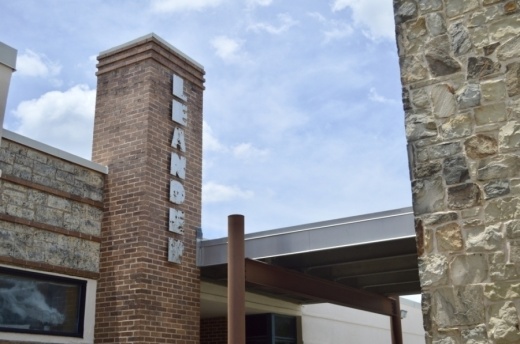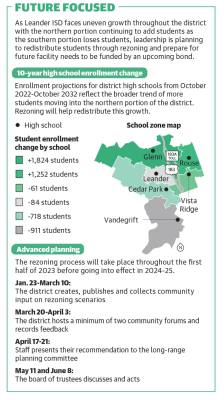The district is preparing to construct Elementary School No. 30—set to open for the 2024-25 school year. Around $63 million has been budgeted for the project. The district has gone through the design phase and is ramping up to begin construction with no groundbreaking date set.
Its opening will require LISD to rezone elementary students—particularly those in the northern portion of the district where the school is being built to relieve overcrowding. Before that takes place, LISD leadership is starting the process to review and rezone all secondary schools.
“We have this problem of unbalanced growth in the district, so part of that is the secondary rezoning will allow us to use the existing capacity that we have inside of existing facilities more equitably across [the district],” Gearing said. “A lot of growth is happening in the north.”
Secondary surges
Between the fall of 2020 and 2021, LISD increased enrollment by 1,425 students. It gained a total of 3,554 students from 2016-21, according to data compiled by Population and Survey Analysts, making it the fastest-growing district in the Austin metro. By 2032, the number of students in LISD is projected to grow from around 42,000 students to 51,083.
Student capacity at Danielson is projected to reach 131% by the 2025-26 school year, while Glenn is projected to reach 124% capacity. To provide enrollment relief at the schools and defer the timing of future school construction, zoning changes will shift the population toward the southern part of the district, Gearing said.
“The demographer had originally projected that we would need two additional high schools, so High School [No.] 7 and then eventually High School [No.] 8,” Gearing said. “By rezoning and using the existing capacity that we have, we think we would be able to avoid building High School [No.] 8 at all.”
LISD’s long-range plan includes the addition of High School No. 7 in the 2028-29 school year and Middle School No. 10 in 2029-30.
With the process for rezoning secondary schools approved by the board of trustees Dec. 8, the district is working to collect community input between Jan. 23-April 3. A minimum of two community forums will be hosted, and recommendations to the long-range planning committee will be made in mid-April. The goal is to announce the new zoning by this summer to allow for a full year before it goes into place for the 2024-25 school year.
Preparing for a bond
In the meantime, the district’s bond steering committee heard recommendations Jan. 3 from advisory groups on what projects need to be prioritized in the coming years. They include upgrades to school HVAC systems, another elementary school, a new campus for the Skills for Enhancing Lifelong Fulfillment program and more. The LISD Citizens’ Facility Advisory Committee is expected to make its final recommendations Jan. 26 to the board of trustees, which has until Feb. 17 to decide on a potential bond election in May.
Gearing said the committee is analyzing what critical needs the district has that require immediate funding—safety and security issues, or emergency items that create a hardship for students, staff or the community.
In 2021, three bond propositions were put before LISD voters. Proposition A, which failed, would have funded $772.2 million of school construction and renovations. Proposition C, proposed to provide $33 million for lighting and sound at the performing arts center, also failed. Proposition B for technology replacement passed, but part of the project required infrastructure within the failed Proposition A.
Looking back, Gearing said the funding from the three bond proposals would have likely fallen short of the actual costs of renovations and construction.
“Now that we’re aware of what those inflation costs look like a little more, whatever we put on the ballot, we’ll make sure that we have enough money built in there to get those projects built,” he said. “So now it’s just a determination of what our community really wants us to do for the children of our community.”






